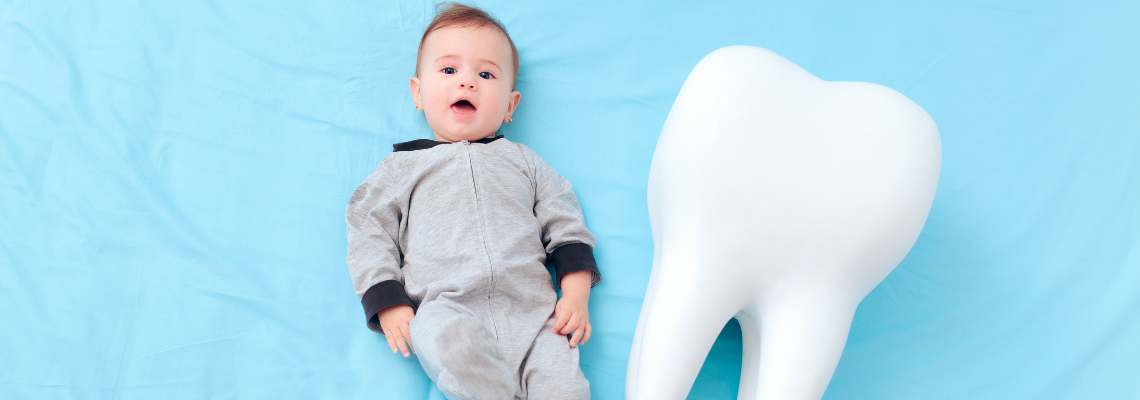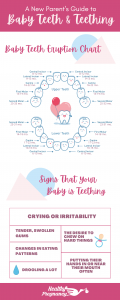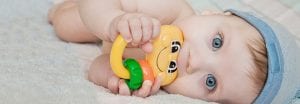
When it comes to a new baby, there is so much to learn, and the new lessons and adventures continue as they grow. Once baby starts approaching 6 months old, and through their toddler years, maneuvering teething and taking care of baby’s growing teeth is one of the many new adventures.
Proper dental care from the beginning of your baby’s life is essential for establishing good oral health that will benefit your child throughout their life. But brushing and flossing isn’t the same for baby as yourself. Be prepared for many differences in the care of baby’s teeth from your own, as it’s a tough time for your baby and he or she will need all of your support and love.
When to Expect Baby’s First Teeth
On average, babies usually are born with 20 baby teeth, also known as primary teeth that are hidden below the gums. In rare occasions, some babies may even be born with teeth that are already showing. These already present teeth are known as natal teeth and occur in about one in every 2,000 births. Not only can it be a shocker to see that your baby is born with teeth, but this condition is believed to occur as a result of prenatal malnutrition or some underlying condition such as chondroectodermal dysplasia (Ellis-van Creveld syndrome), pachyonychia congenita, or Hallermann-Streiff syndrome.
There is one other classification of teething known as neonatal teething, which occurs when your baby develops teeth very quickly, within the first 30-days after birth. This is even more rare than being born with teeth. Just like with natal teeth, the main concern is if the teeth are lose or have any root issues.

Beyond the rare cases of natal and neonatal teeth, with most babies, the exact timing of a baby’s first tooth eruption may vary, typically babies will begin teething around six-months of age. However, some babies may begin teething a little earlier or a little later than this, even as late as 12-months. If this is the case with your child, rest assured, late teething is nothing to be concerned about.
As a general rule as baby teeth begin to make their breakthrough, as long as the teeth aren’t loose, there isn’t anything to worry about. However, if baby teeth are coming in loose, the loose teeth can lead to feeding problems or a choking hazard so your doctor may recommend that you have them surgically removed.
Signs That Your Baby is Teething
Teething can be quite uncomfortable for babies and although baby may not be able to tell you exactly when they have new teeth breaking through, there are quite a few tell-tale signs of the event (except in the case of natal or neonatal teeth, where the baby doesn’t have time to exhibit symptoms).
Here are some of the early signs of teething:
- Crying or irritability
- Tender, swollen gums
- The desire to chew on hard things
- Putting their hands in or near their mouth often
- Changes in eating patterns
- Drooling a lot
Though it can be tough to see your baby go through the pain and discomfort of teething, by identifying when it is occurring, there are some ways you can help comfort your baby and ease the pain during the process. Some of the most helpful tried and true practices for helping baby with teething include:
- Gentle gum massages
- Allowing baby to chew on a cold, damp washcloth or a cool teething toy
- Pain medications or teething drops specifically for babies
- Chilled pureed foods and drinks to ease inflammation and pain
- A lot of extra cuddling can also be very helpful
Click here for additional Tips for Soothing a Teething Baby
Baby’s Teething Timeline
In general, baby teeth development follows a similar schedule for most. Typically, the lower central incisors (lower front teeth) will be the first to develop around six to ten-months of age followed by the upper central incisors (upper front teeth) shortly after. Next, you’ll see the top and bottom lateral incisors and canines (the teeth that surround the central incisors) around nine to 23-months old with the top ones likely coming in first. The first baby molars will come in next around 13 to 19-months of age, followed by the second molars around 23 to 33-months of age.
In general, as the baby teeth come in, having space between each baby tooth is a good thing, as it indicates there should be room for the permanent teeth to come in when the time comes. If you start to notice that your child’s baby teeth are crowded or their front teeth are protrusive however, this could be an early sign of something an orthodontist should monitor and you may want to schedule your child for a dentist check-up to get their opinion.
Additional signs that your baby’s teeth or bite may not be right include:
- Early or late loss of baby teeth
- Difficulty in chewing or biting
- Mouth breathing
- Jaws that shift or make sounds
- Biting the cheek or the roof of the mouth
- Facial imbalance
- Grinding or clenching of jaw
While we eventually have 32 teeth as an adult, babies will only develop 20 primary teeth, which will begin to shed around the age of six-years-old, after which, the permanent teeth will begin coming in at about six-years-old and start to replace the primary teeth that were once present.
Oral Hygiene Before and During Teething
Although your baby may not have teeth yet, practicing healthy oral habits can prevent or reduce tooth decay (cavities), in infants, so establishing a good oral hygiene routine early is important.
 You can begin by gently wiping your baby’s gums using a damp, clean wash cloth after feedings. To do this, cradle your baby with one arm, wrap a moistened washcloth around a finger of your free hand, and gently massage the gum tissues. Since dental decay is an infectious transmissible disease, avoid testing bottle temperatures with your mouth, or cleaning a pacifier or bottle nipple by putting it in your mouth. By cleaning and massaging your baby’s gums, this practice can help with the teething process when the time comes. More importantly, your baby will be use to oral hygiene practices, which will make things easier when they finally develop baby teeth and it’s time to get in there to brush and clean them.
You can begin by gently wiping your baby’s gums using a damp, clean wash cloth after feedings. To do this, cradle your baby with one arm, wrap a moistened washcloth around a finger of your free hand, and gently massage the gum tissues. Since dental decay is an infectious transmissible disease, avoid testing bottle temperatures with your mouth, or cleaning a pacifier or bottle nipple by putting it in your mouth. By cleaning and massaging your baby’s gums, this practice can help with the teething process when the time comes. More importantly, your baby will be use to oral hygiene practices, which will make things easier when they finally develop baby teeth and it’s time to get in there to brush and clean them.
Between the ages of six to 12 months, your baby will begin having their baby teeth start erupting and teething will be a continuous occurrence as their first 20 teeth make their appearance. It is important to care for each tooth from the start. During this time, continue to clean your baby’s gums after feeding. Once teeth start to come in, use a child’s soft bristled toothbrush, with no toothpaste, in addition to massaging the gum tissues. Begin to wean your infant from using a bottle as they become more familiar with solid foods and become familiar with the appearance of your child’s gums and teeth by regularly, lifting his/her lips to check for unfamiliar spots on the teeth, which may indicate dental decay, and be sure to schedule an appointment with your infant’s dentist right away to have them checked out.
Around the time of baby’s first birthday, or within six months after the first tooth appearance, be sure to schedule your child’s first dentist appointment. You can also speak to your pediatrician or dentist about infant fluoride supplements if necessary.
During this time frame, continue to brush your child’s teeth twice a day using plain water, or fluoridated water, and a smear of fluoride toothpaste (the size of a grain of rice), and continue to regularly check his/her teeth and gums for any suspicious spots.
If you are unsure about the amount or type of toothpaste to use, be sure to reach out to your pediatrician or child’s dentist to clarify any concerns or questions you may have.
By 30 months of age, most infants have acquired all of the primary teeth.
At about age two, begin brushing their teeth using a pea-sized amount of fluoridated toothpaste and work with your child to teach them how to spit out the toothpaste after brushing, and begin to teach your child how to brush his/her own teeth, ensuring that teeth brushing time is supervised to ensure proper cleaning is done and to avoid choking. Generally, children will need help with brushing their teeth until they have the hand coordination to do so effectively.
Continue regular oral hygiene checks, daily practices, and regular dental checkups. By age six or seven, children should be able to brush their own teeth, unsupervised and have a daily routine of taking care of their oral hygiene.
In Summary…
Taking care of your baby encompasses a lot, so it’s no surprise that you’re looking up information on the teething process. This is a delicate time for a baby and the level of ease at which they get through it is totally dependent on the parent. However, with the information provided, your baby’s teeth won’t be so hard to take care of.
The biggest issue you’ll face is comforting your baby through the teething process, and with proper oral hygiene practices from the start, you’ll see that it’s no real issue at all and baby will be well on their way to a healthy smile of pearly whites.


